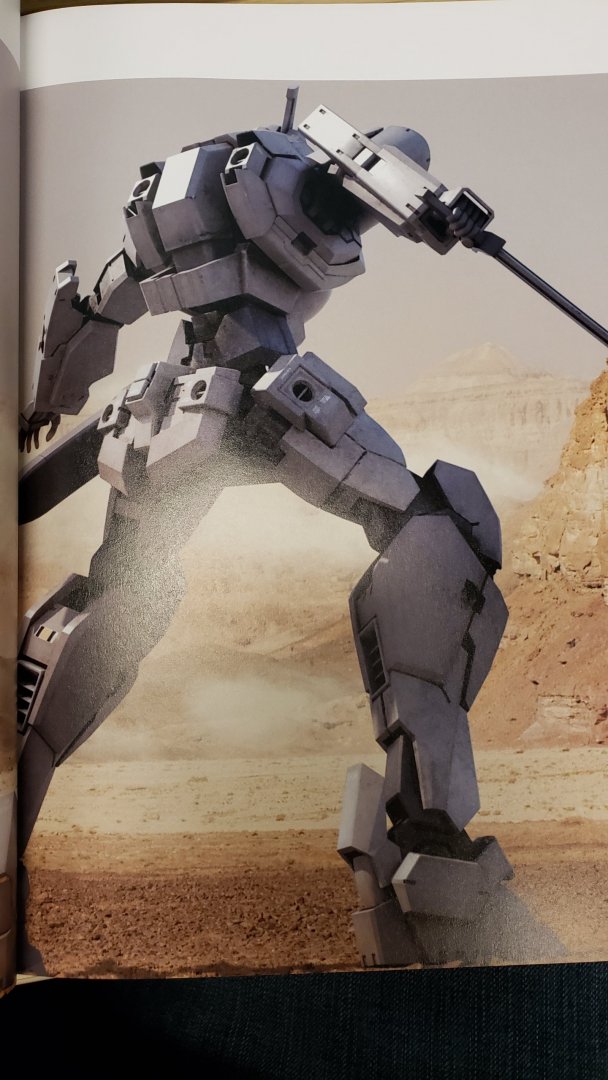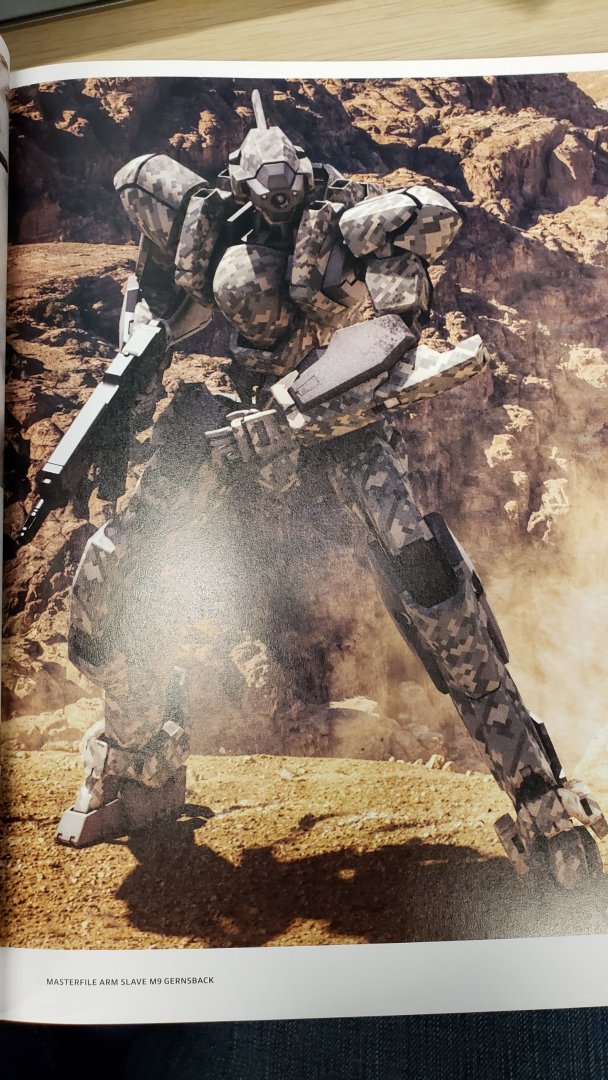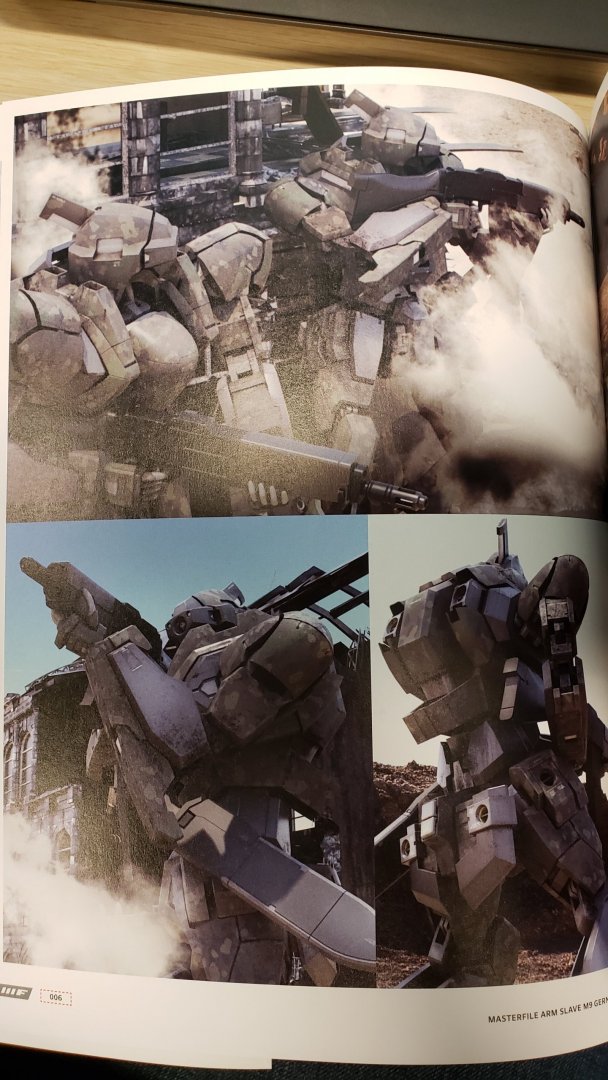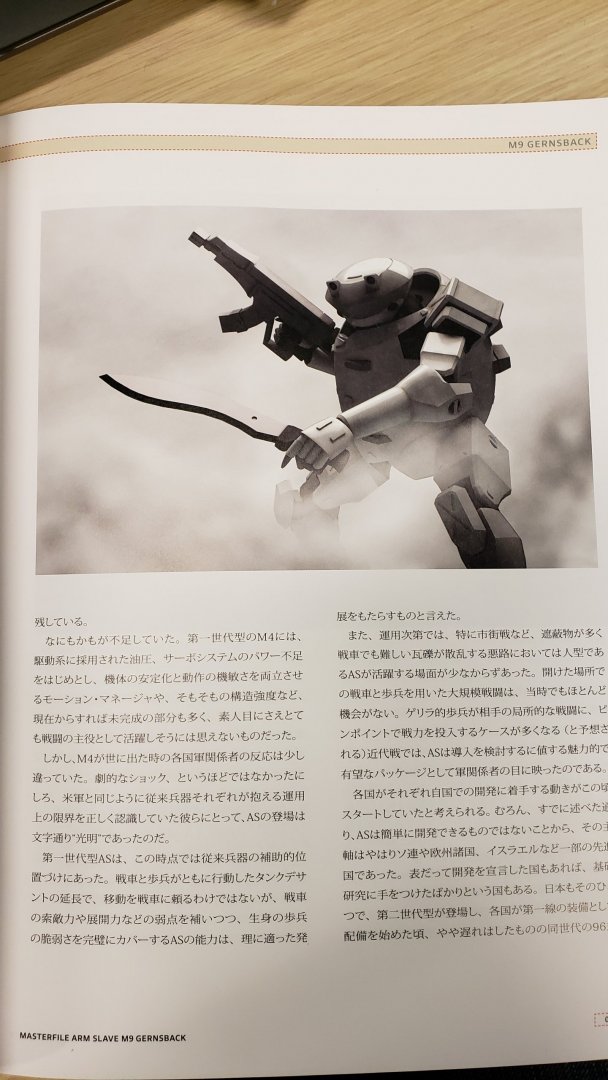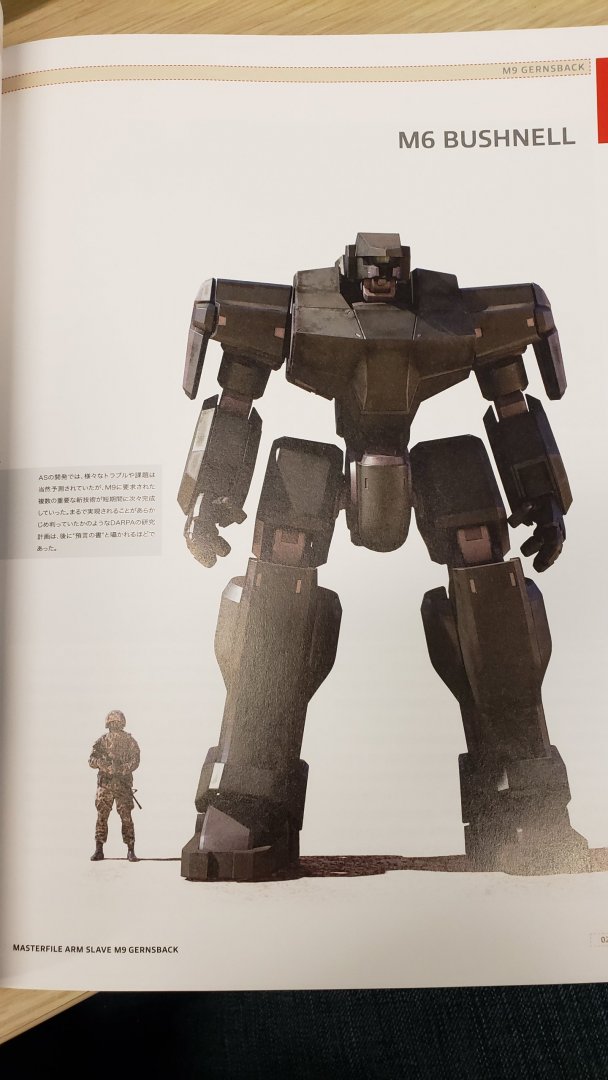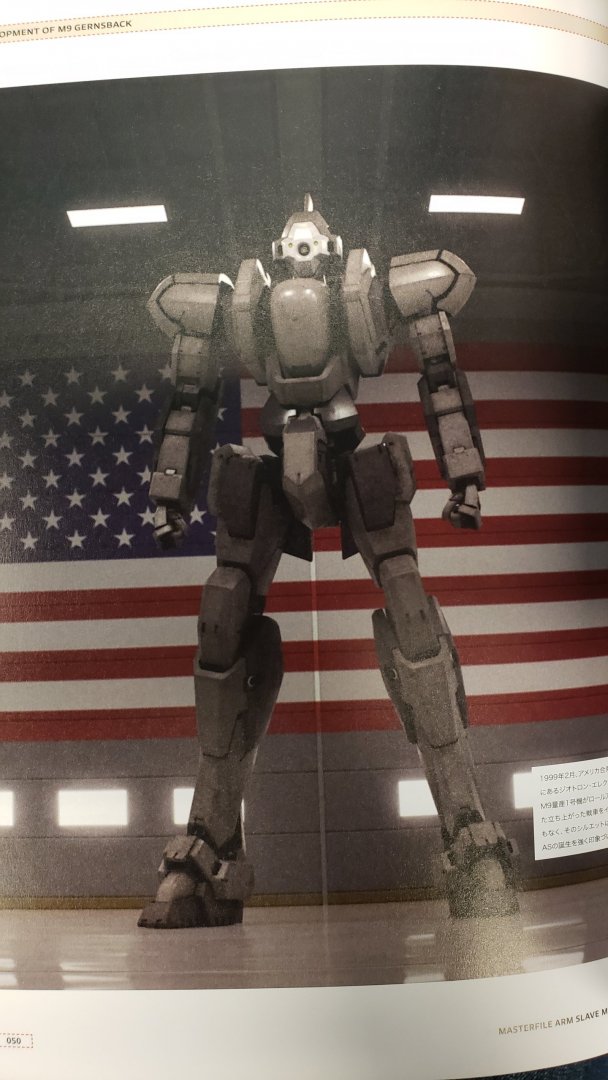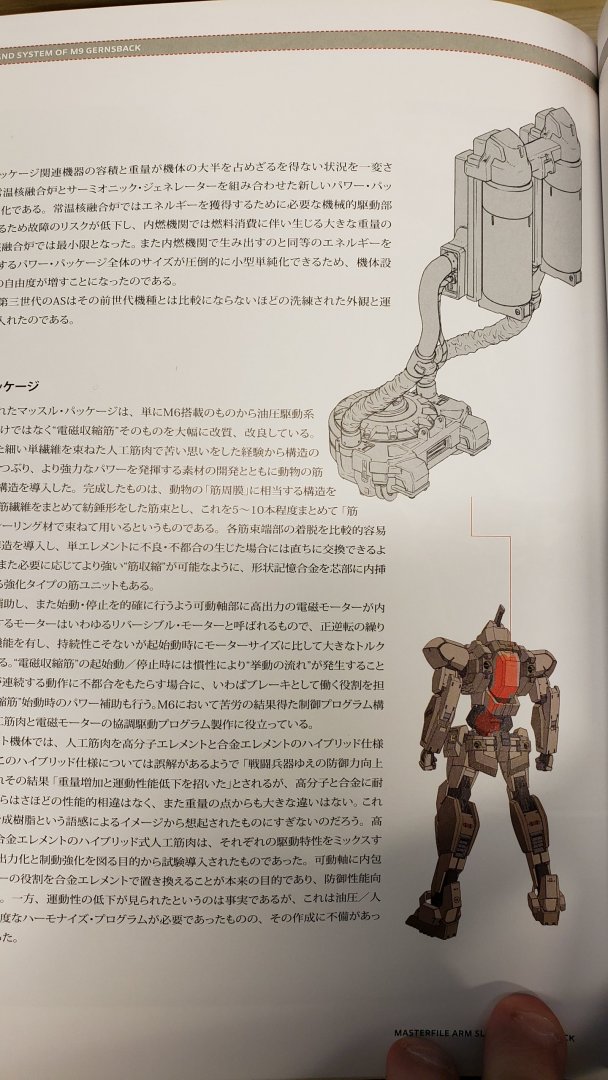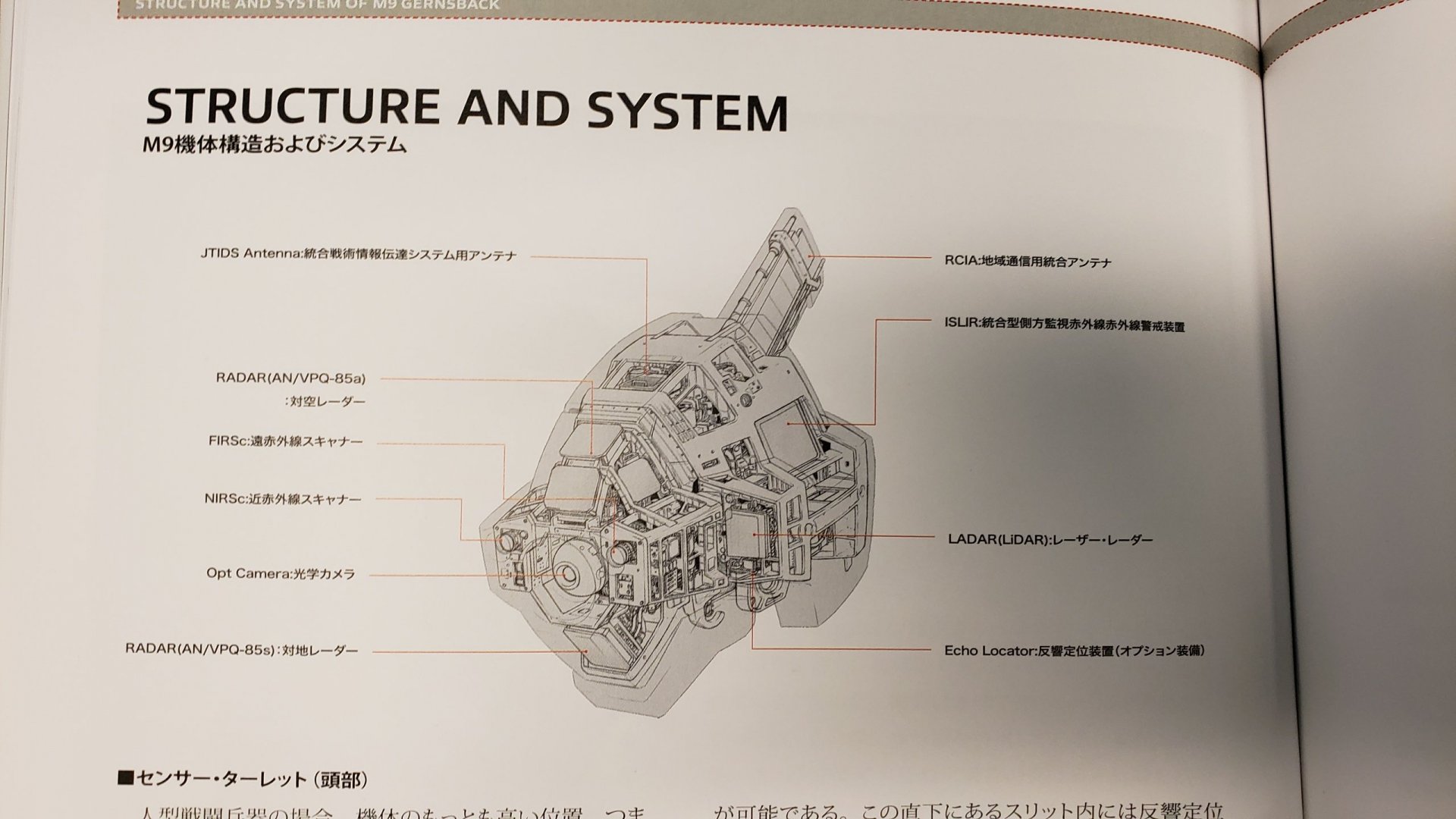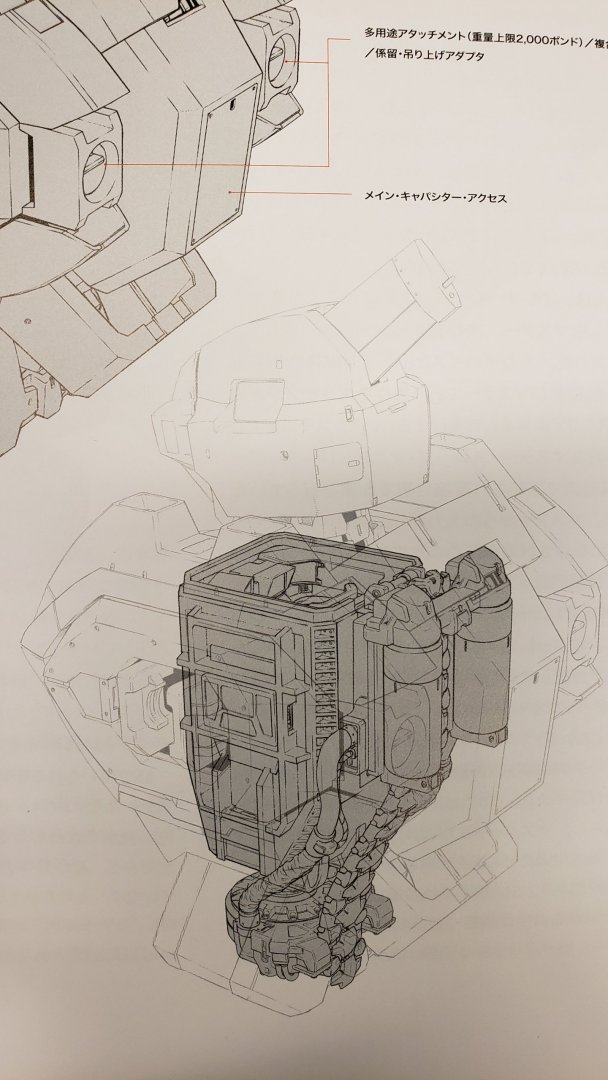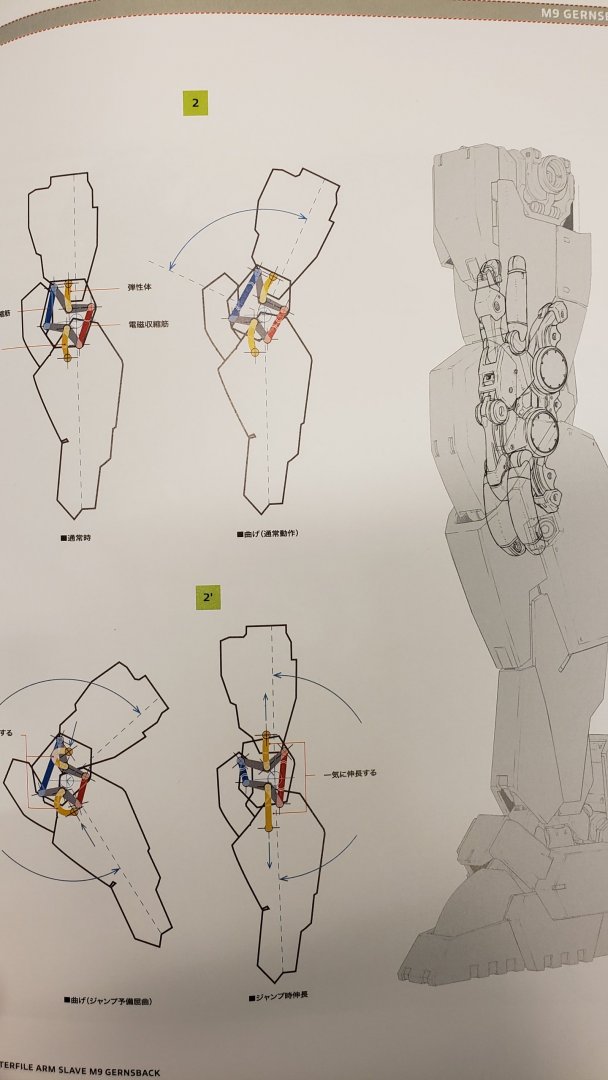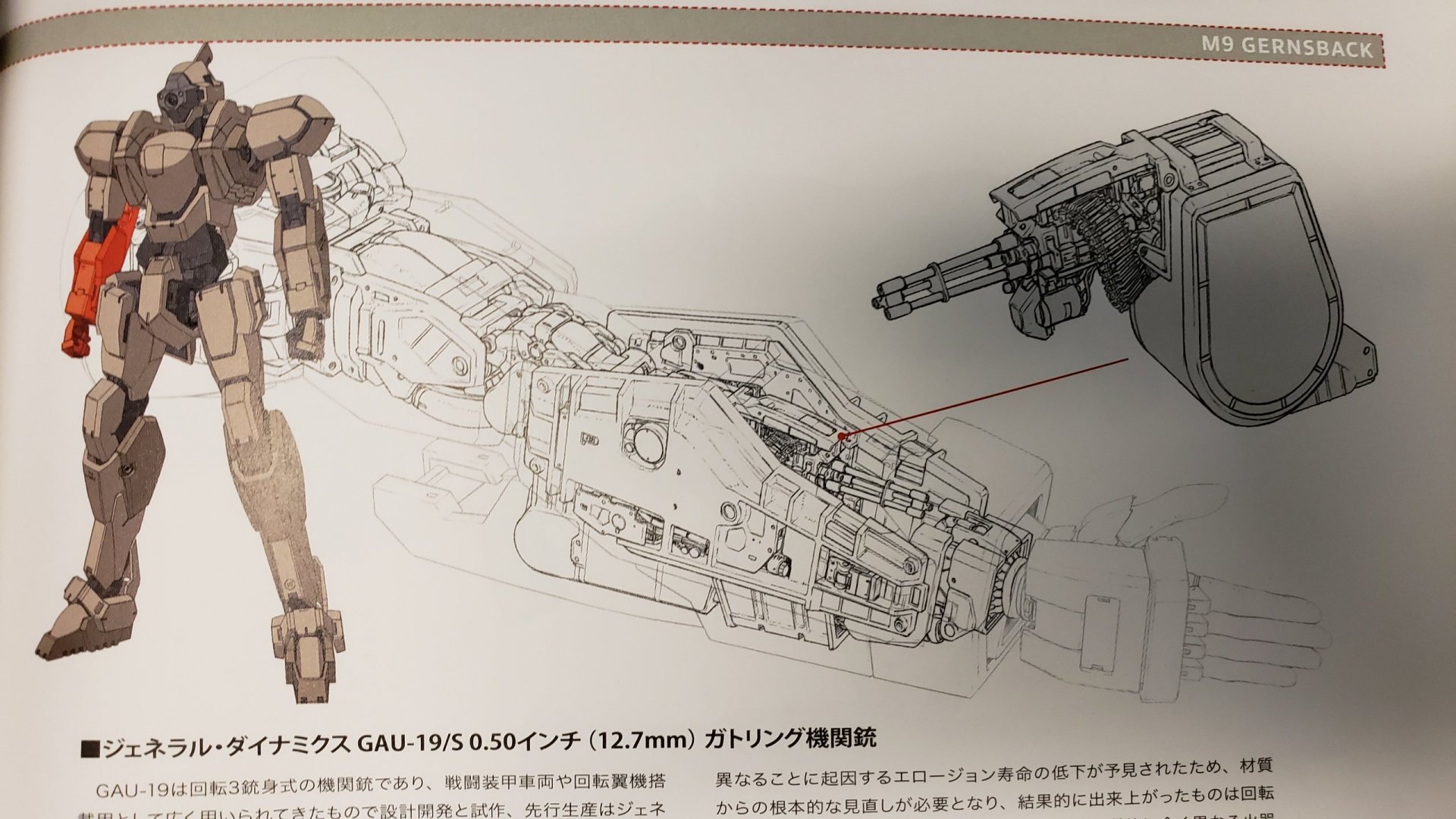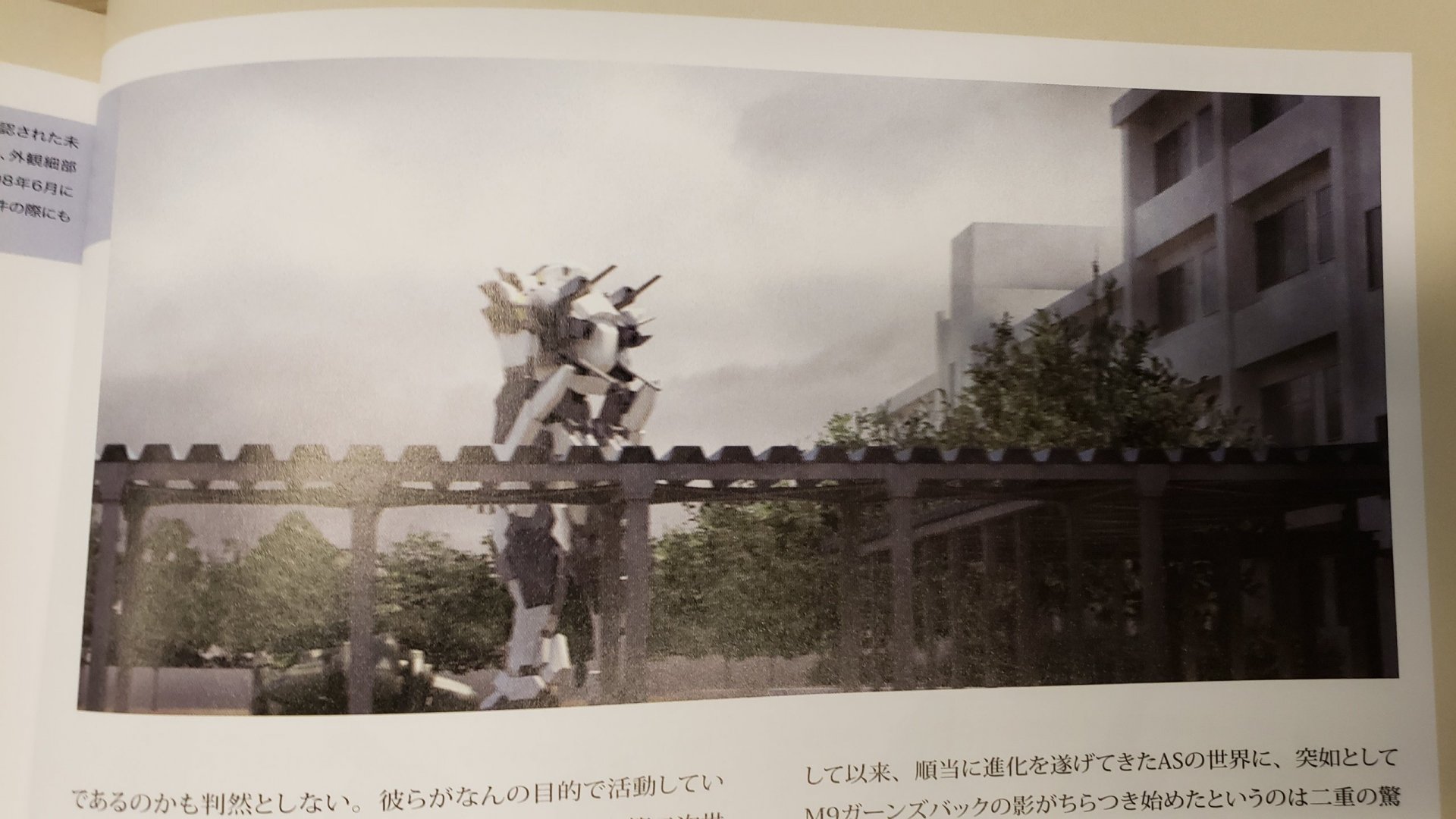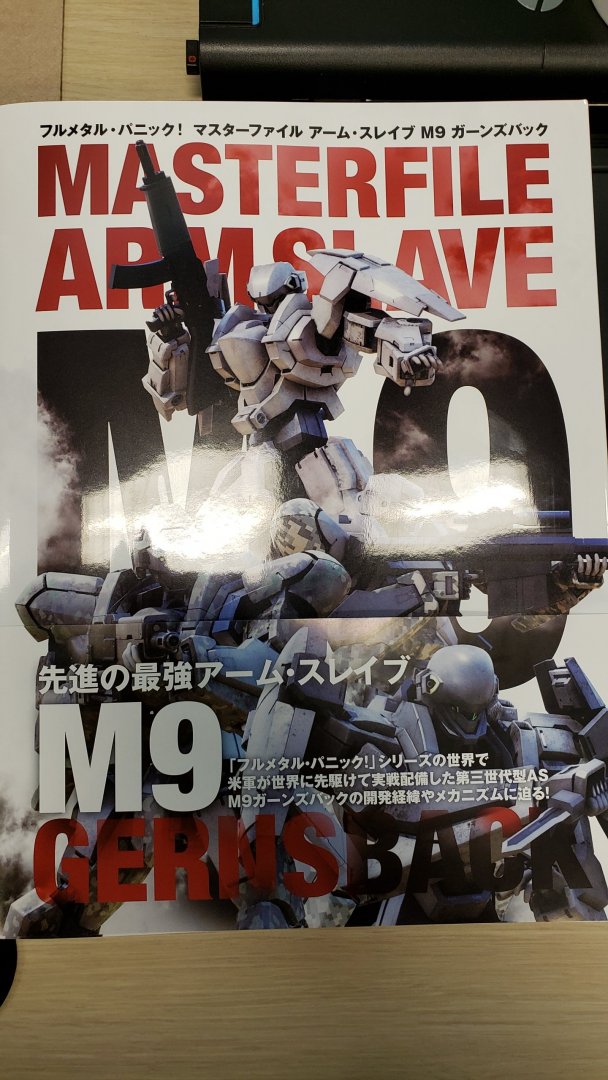-
Posts
12218 -
Joined
-
Last visited
Content Type
Profiles
Forums
Events
Gallery
Everything posted by Seto Kaiba
-
Hasegawa's already supporting the Master File line and they had their fingers in Macross the Ride, so it might not be a bridge too far...
-
Iiiinteresting... I wonder if this will be the announcement of the new Pokemon main series game they were teasing. Incidentally, after replaying the The Room quadrilogy and the Zero Escape trilogy my jones for horror/puzzle games still isn't satisfied. Nintendo recommended Dying: Reborn, but I can't seem to find much of anything about it. It came out about a month ago. Has anyone given this game a go?
- 1050 replies
-
Attached are some shots of the book's contents... it has an abnormally large number of full-page images, but they're pretty well done. (Since it's not immediately clear what this diagram is... that is the M9's Ross & Humbleton APR2500a palladium thermionic reactor. I rather liked this diagram, which shows the movement of the mechanical articulations inside the M9's knee joint. The US Army M9 Gernsback mass production type eliminated the two 12.7mm chainguns in the head in favor of replacing the XM18 wire gun in the right arm with a single 12.7mm rotary cannon.
- 347 replies
-
- Full Metal Panic
- toys
-
(and 3 more)
Tagged with:
-

New Macross TV Series in 20xx (sometime this decade)
Seto Kaiba replied to Tochiro's topic in Movies and TV Series
Minmay doesn't fit the profile any more than any other character... we just don't have any existing character from the First Space War with an M-name who was a brilliant and wealthy industrialist. Lynn Minmay was a great singer, but she wasn't the sharpest knife in the drawer and definitely wasn't the sort who could found and run an interstellar communications firm (especially since she went missing in deep space in 2016 and hasn't been heard from since). -
Despite name-dropping the main Full Metal Panic! series on the obi, it does seem to be written more with fans of Full Metal Panic! Another in mind. Most unhelpfully, Master File Arm Slave: M9 Gernsback omitted the Master File/Master Archive series's usual dated foreword. When it was active, MITHRIL was an open secret among the NATO brass and SpecOps units. Civilians were dimly aware of it only via conspiracy theories, which MITHRIL encouraged to discredit anyone who attempted to publicize their existence. This book appears to have been written in-universe a couple years after Full Metal Panic! Another (2011-2012), so by then MITHRIL had been a defunct organization for 15+ years and its few surviving staff had moved on to the private sector or disappeared. I guess the MITHRIL section is that there's not a MITHRIL AI operating anymore to discredit people who had photographic evidence of MITHRIL operations like the highly public confrontation in front of Tokyo Jindai HS.
- 347 replies
-
- Full Metal Panic
- toys
-
(and 3 more)
Tagged with:
-

Super Macross Mecha Fun Time Discussion Thread!
Seto Kaiba replied to Valkyrie Driver's topic in Movies and TV Series
By necessity, the ordnance containers are all pretty streamlined in their folded/stowed configuration to minimize the potential aerodynamic disruption they might cause. I'd imagine the boundary layer control system is probably doing at least a little to help mitigate any disruption to vortex flow that might occur as a result of one container or another, though I have nothing to go on for that but a hunch. The LU-18A is also a pretty darn streamlined design even as gunpods go, so its disruption would've been minimal even when it was sticking out of the underside of the container. That's debatable... but we could reasonably say that it wasn't AS severely outmatched. What the NUNS and Xaos really had going for them in the Windermere War was that the Kingdom of the Wind really massively screwed up when ordering its next-generation main fighters from the Epsilon Foundation. Someone in authority, it might've even been King Grammier himself, decided to go for a fighter that fit the ancient martial ethos of the Aerial Knights that had been handed down from the days when they were riding around on giant birds twatting each other with sharp bits of metal. Windermere IV brought a superlative atmospheric dogfighter to a space war. That huge advantage in engine power and maneuverability they have between the superior ISC, more powerful engines and the fold reheat system doesn't mean much if they don't have the reaction mass to leverage it. It's a question of degree. Take, for instance, the VF-1 Valkyrie's RMS-1 thermonuclear reaction missile and the RO-X2A double-action beam cannon from its Strike Pack. They're both anti-warship weapons, but one will blow a hole hundreds of meters across in a warship and the other will make a pair of neat little holes 18cm in diameter. Same deal here. The VB-6 Konig Monster's railguns are firing hypervelocity shells with thermonuclear reaction warheads. Each one will knock a quarter-kilometer hole in an enemy ship, and they're fired four at a time most of the time. The beam turrets on the VF-25 Tornado Messiah, YF-29 Durandal/Perceval, and VF-31 Armored Siegfried have enough stopping power to get through warship armor (which considering what we've heard about how tough that stuff is, is nothing to sneeze at and totally justifies them being a one-hit kill on mecha) but they aren't going to be blowing massive craters in the hull. It's the same type of turret we're told is used as a defense turret on carriers (in the YF-29's Mechanic Sheet). You can sink a ship with one if you hit it in the right places (like when Keith took out a stealth cruiser by shooting out the bridge tower), but it's not going to be wholesale destruction of the ship like you'd get from a thermonuclear warhead detonation. There was a MUCH bigger difference in price tag between the VF-1 and the Series 04 Destroids than 1:3. Try 1:20. That actually had some curious implications for the one publication that actually put a firm price on the VF-1 Valkyrie. The Sky Angels book from '84 - which is also the origin of that little factoid about cost difference - gave the VF-1's flyaway cost as $126 million, which would mean the typical destroid only costs around $6.3 million... only slightly more than a then-modern MBT like the M1A2 Abrams. (Bear in mind this was written in '84, when $126 million would've been an outrageous sum for a single fighter... somewhere between three and seven times what a then-modern jet fighter would cost. By today's standards, it'd be considered quite reasonable.) -

Super Macross Mecha Fun Time Discussion Thread!
Seto Kaiba replied to Valkyrie Driver's topic in Movies and TV Series
It's a rich text editor... bbcode is categorically unnecessary. You can quote just by highlighting the text you want to quote and a context button will pop up saying "Quote selection". Text manipulation otherwise works just like your choice of desktop text editor (Word, Docs, etc.). The ordnance container is described as standard equipment for the YF-30 and VF-31. One is always fitted in the course of normal operations, and not having one compromises the fighter's balance and aerodynamics. At the present point in Macross history, conflict between rival powers armed with VFs is arguably the bigger strategic concern with the primary Vajra hive having left the galaxy. The Second Unification War was less than twenty years ago, and ironically both of the commanders in the early phases of the war with Windermere IV were veterans of it. The Zentradi are still an existential threat, but encounters with them are mercifully few and far between, while there is an ongoing problem with armed anti-government groups like FASCES and the group who hijacked the emigrant ship in the incident that drove Mirage to quit the NUNS. The whole situation with Windermere kind of draws a line under it too, since they're not even that powerful and still raised all kinds of hell as a minor and economically stagnant power armed with 5th Gen VFs. (Mind you, their relative inexperience did come back to bite them later on, when more experienced pilots in inferior fighters started cleaning their clocks when they weren't able to use the Song of the Wind to remove the NUNS's numerical advantage.) To be fair, since it isn't a plot armor thing the "Who" doesn't really matter as much as how consistent the result was. The VB-6's railguns and the VF-31 Armored Pack's beam turret are built to do two fundamentally different jobs. The VB-6's railguns are for delivering thermonuclear reaction shells at high velocity for precision attack or saturation bombardment. The VF-31 Armored's beam cannon turret was more or less the same deal as the one on the VF-25 Tornado Messiah or YF-29... the sort of turreted beam weapon we're told is used for CIWS purposes on warships. It's not going to be anywhere near as destructive as the Konig's railguns, and is probably less destructive than the beam turrets on the Tornado Messiah or Durandal/Perceval given that it isn't a MDE beam cannon (for in-universe legal reasons?). If it's based on the Tornado Messiah's turret - and from the description in the stats it sounds like it's at least similar in its basic design - then its use is probably REALLY limited too. The Tornado Messiah's turret only had enough energy to fire for five seconds at full power. You might be thinking of the cost difference between the NUNS AIF-7S and VF-171 there? Odds are the vastly more advanced VF-31 is going to cost a fair bit more than the VF-171. I'm not sure how the Cheyenne II would shake out compared to the AIF-7S, since in the VF-1's generation a Destroid cost 1/20th of what a VF did but the Cheyenne II is both a 50+ year old design and modernized while the AIF-7S is vastly simpler mechanically except for its engines but is packed to bursting with state of the art electronics. I confess I'm not certain as to the viability of that tactic. It takes a LOT of stopping power to bring a Vajra down... maybe dozens of EX-Gear suits, each carrying the warhead from a micromissile. They should be more than capable of lifting those if the weight hasn't increased too much. First-gen micromissile warheads were supposedly only about 20kg. I'd question attributing better survivability to it though, since the Beatrice tanks were only taken out by the Vajra's heaviest anti-capital ship heavy quantum cannon and even the Vajra's lightest beam machine gun is sufficient to destroy EX-Gear parts as we saw in the Frontier movies. I'd think the risk might actually be greater for the EX-Gear pilot since the Vajra can just spray the air with shots and expect to kill anything it hits, whereas a smart tank commander could fire from the move and have a better chance of surviving a near miss from the big gun. (FWIW, the Beatrice crews were incredible idiots parking to fire against a high mobility enemy... but I guess their options were limited by the terrain.) -

Super Macross Mecha Fun Time Discussion Thread!
Seto Kaiba replied to Valkyrie Driver's topic in Movies and TV Series
IPB uses a rich text editor. bbcode is for plain text editors, but IPB'll parse it if it's used. Looks like you've accidentally nested quotes by missing some closing quote tags. ... but then it wouldn't be an apples-to-apples comparison if you added extra, nonstandard weight to the VF-25. The whole point there was that the VF-31's stats are misleading precisely because the empty weight given specifically excludes the weight of standard equipment... meaning that it isn't an honest empty weight for the aircraft by the standard definition of "empty weight". It'd be like giving the VF-25's empty weight with all the system fluids drained out or minus one of its arms. Citing a "character" who has about fifteen seconds of screen time strikes me as a really bad, terribly misleading reference point. The use of Advanced Energy Converting Armor for the VF-25's anti-projectile shield isn't cutting corners... it was a prudent, anticipatory move on the part of Shinsei and LAI to provide adequate defensive ability against an enemy whose performance was at least equal to a 5th Generation VF's. Pinpoint barriers alone weren't equal to the task of protecting a VF from the kind of firepower 5th Generation VFs were equipped with, since they could be brought down by a particularly heavy hit or chipped down by sustained light fire as we see occur at several different points in Macross Frontier and Macross Delta. The VF-31 may have gone back to layered standard energy converting armor as a cost save, but as we see on several different occasions the VF-31's anti-projectile shields just aren't equal to the task of protecting the VF from the firepower of another 5th Gen VF... even with a pinpoint barrier's support. So far, the VB-6 seems to be one of those designs that will just keep getting updated and stay in service for-freaking-ever... like the B-52. One of the advantages of a large, especially roomy, fuselage I suppose. Most any VF can lug a half-dozen reaction missiles into combat and achieve the same results the Armored Pack did. The Konig's advantage is that it carries way more than just one salvo's worth and it's delivering those warheads to target much faster and with lower probability of intercept by sending them along at greater velocities using railguns. As close combat-focused as the VF-31's Armored Pack is, the inclusion of the reaction missiles feels almost like an afterthought when everything else it has is focused exclusively on ultra-short-range combat like pretty much every other Armored Pack has been. That "rusty destroid nostalgia" costs a tiny fraction of what the APS-25A/MF25 does... that advanced energy converting armor is NOT cheap. The Macross Frontier fleet is a particularly wealthy one, and Strategic Military Services isn't exactly short on funds either, but with SMS's VF-25s and their optional gear essentially on loan from the New UN Spacy it was probably more cash than the military was willing to put up during the operational evaluation period. It's doubtful that an EX-Gear suit could withstand the recoil force of a weapon powerful enough to actually kill a Vajra and the farther away from that blast you are the better. Using mortars would be problematic on something that mobile too, and would probably result in a fair amount of accidental collateral damage. -
My copy just rolled in this morning, practically still warm from the printing press. It's not quite what I had expected. Indeed, in the most erect of dick moves the MITHRIL M9 Gernsback isn't even on the actual cover... just the obi. It feels a bit like false advertising since that's the M9 that everyone's most familiar with from the light novel, anime, manga, etc. Virtually all of Master File Arm Slave: M9 Gernsback is about the mass production Geotron M9 Gernsback used by the US Army. Most of the coverage is of the initial production type M9 Gernsback (front left) that appeared only briefly in the ninth volume of the Full Metal Panic! light novel in the hands of Delta Force. The M9A2 Gernsback Enhanced (facing right) and M9A2SOP Gernsback Sigma Elite (top center) from Full Metal Panic! Another figure less prominently, but still get a decent amount of attention. All mention of MITHRIL and the M9s it used are crammed into the last ten pages, which is mostly "amateur photos" of them in the field. Not a bad book by any means, but I feel like more attention should've been given to the MITHRIL XM9D Falke, XM9E Gernsback, and ARX-7 Arbalest. EDIT: Will post some photos of the contents later today.
- 347 replies
-
- Full Metal Panic
- toys
-
(and 3 more)
Tagged with:
-
I'm hoping we'll see some references to Macross the Ride in this one... not just because Master File tends to throw in nods to model kits and that light novel used custom model kits to represent all the fighters in the story, but because that was the single greatest concentration of VF-11 action in the last decade-plus if you don't count Mina Forte's VF-11C in Macross 30: Voices Across the Galaxy. It was a nice touch to not only have the VF-11 more or less be the standard for Vanquish racing, but that it has its own dedicating racing class... being the equivalent of a VF stock car.
-

Super Macross Mecha Fun Time Discussion Thread!
Seto Kaiba replied to Valkyrie Driver's topic in Movies and TV Series
That appears to have been an honest mistake on my part... I must've been reading from the wrong line on my VF Tech Spec cheat sheet. Good catch. There are two interrelated problems with your reasoning... namely, you're assuming there is a universally applicable definition of "empty" for the ordnance containers and that that definition means that the container is just an empty shell. Neither is the case. "Container" is probably a misnomer to begin with, since the contents of the container are not swapped... the containers themselves are. The equipment is physically a part of, or in some cases simply IS, the so-called container. As such, the empty weight of the containers is going to vary wildly depending on what container you're looking at and whether that container even has any consumables in it. Being that the container is an approximately 9x2x2m rectangular box made of the same armor material as the rest of the fighter, it's very doubtful any container configuration is going to weigh less than the 330kg it would take to eradicate the VF-31A-1's container-free thrust-to-weight ratio advantage over the VF-25A-1. Three of the five known official container configurations are fixed equipment with no known consumables to cause a weight difference between empty and standard operating: the YF-30's MDE beam gun container, the VF-31's fold wave radome container, and the VF-31's projection unit container. The other two - the YF-30's missile container and the VF-31's multidrone charger container - do have parts that can be counted out but they also still have significant amounts of built-in equipment. Even if we were charitable and assumed an empty missile container only weighed as much as the HMMP-02 micro-missile launcher on the VF-1's Super Pack (despite being three times as big), that's twice the weight it'd take to remove the VF-31's container-free advantage. Even if it only weighed as much as a GU-11 without any bullets in it (550kg), that would still be enough to tip the scales past even and into the VF-25's favor. The VF-31A is an acknowledged cheap design that shares an awful lot of parts with that ten year old design. It's not like the VF-31 was an all-new, all-original aircraft. It was kept cheap by using off-the-shelf parts. Mind you, it should also be carefully noted that we're comparing the VF-31A Kairos trial production spec c.2067 against the VF-25 Messiah trial production lot c.2058. It's unlikely in the extreme that the VF-25 hasn't been subjected to numerous upgrades in the intervening nine years, especially given that it was still in OPEVAL in 2059. (Hell, it got a couple small upgrades right there in the show.) The VF-31 may have twice as many forearm-mounted shields, but they're made from inferior materials and are much smaller to boot... as seen in the series, the VF-31 relies mainly on its pinpoint barrier system for defense. (The VF-25 has a similar bolt-on armor reinforcement for its antiprojectile shield as well.) I'm not seein' it... they're not remotely similar, given that the VB-6 is an artillery unit delivering intermediate-yield thermonuclear reaction shells while the VF-31 Armor Pack is a micro-missile spamming close-in attacker. In all fairness, the feature that deserves that praise is the ordnance container... simplifying logistics was the entire point of the thing. Hot-swappable mission modules more or less eliminated the need for several different specialized variants. Really, the Aether and Hemera - or Enterprise-class as Master File is the only book to name it - are a terribly inefficient design. There are so many gimmicky and unnecessary moving parts like the folding flight deck, pop-out engine nacelles, and retractable stage that they can't be making very good use of the ship's internal space. The ARMD-L-class carrier parts used by the Macross Quarter-class are vastly more efficient designs because they ascribe to the K.I.S.S. engineering philosophy of the ARMD-type warships, being essentially a box which has been fitted with a bunch of airlock-elevators and catapults. Despite one, and possibly both, ships having a heavy converging beam cannon built into it they're both officially classified as carriers... CV/C-109 and CV/C-110 respectively. They don't seem to have any evident defenses besides barrier systems and point-defense guns. (Even the mercilessly economized Guantanamo-class has more than that.) -

Super Macross Mecha Fun Time Discussion Thread!
Seto Kaiba replied to Valkyrie Driver's topic in Movies and TV Series
You totally need the red paint, the horn, the mask, and the sister complex for that. -

Super Macross Mecha Fun Time Discussion Thread!
Seto Kaiba replied to Valkyrie Driver's topic in Movies and TV Series
Eh, we're happy to answer it all the same. Xaos Valkyrie Works adopted a forward-swept delta wing configuration on their Siegfried custom VF-31s to improve the aircraft's maneuverability at low speeds in atmospheric flight. Since Delta Flight's role was operating in support of Walkure in airshows at their performances and providing close air support for Tactical Sound Unit operations on the battlefield, an aerodynamic modification to improve maneuverability in low speed, low altitude flight would have been a common sense move. That's not really an issue for the production-intent VF-31, so its close-coupled canard delta wing's greater structural rigidity, stability, and smoother flight at low speeds. The Siegfried is an "Ace Custom" in the longstanding mecha anime tradition... each of the five Siegfrieds is a unique, custom aircraft tailored to its pilot with higher performance than the mass production version. The VF-31 itself is a significantly detuned and heavily economized version of the YF-30 comparable in performance to, and sharing a fair amount of hardware with, the VF-25. Xaos Valkyrie Works started with the stock VF-31A (as seen in the flashback episode), and made a series of upgrades and one or two selective downgrades in order to produce their Siegfried custom specification. The VF-31's stock FF-3001A Stage II thermonuclear reaction turbine engines were replaced with a derated version of the FF-3001/FC2 engines which were used on the YF-30, for a 14% improvement in maximum thrust. Its stock ARIEL II integrated airframe management and control AI was replaced with a custom AI optimized for close air support of Walkure. It was given a Fold Wave System and fold quartz amplifiers similar to the YF-29's to boost its performance. The wing design was changed to forward-swept to improve maneuverability performance at low speeds. On the "downgrade" side, the ordnance bay in the engine nacelle/leg was gutted and replaced with a storage rack containing multidrone plates and the forearm/wing root-mounted railguns were swapped for a less-powerful, lower-caliber model to reduce the possibility of accidental injury or collateral damage. -
It was inevitable after the book ahead of it in the queue (the M9 Gernsback Master File) got pushed back a month.
-
Officially, the VF-1 only has four. The six pylon configuration seen on a few toys and model kits was shortcut to getting six RMS-1s on the wings without having to mold and cast the two missile pylon configuration used in DYRL?. Master File presented that as a variant wing design pretty much solely for RMS-1s. (It also, even more bizarrely, offered a variant wing with five pylon stations but failed to come up with a configuration where all five could be used at once.) The VF-4 had, depending on which art you consult, either six or eight. The cover art looks nice, though I'm more in the Master File books for the tech trivia and the VF-11 is both a personal favorite and a sorely neglected VF.
-
I'm oddly amused that they not only took the time to mention that the 11th book in the Variable Fighter Master File series was the VF-11's, but that their declaration of the fact is absolutely dominating the book's obi. After the return to high quality in the Battroid Valkyrie book I'm sincerely hoping that they've done the VF-11 justice in this one. That said, the cover alone already has something to give me pause. They've drawn that VF-11B with three pylons per wing. The only official depiction of a VF-11 with wing pylons to date only had two. Not an auspicious start... but still, I can hardly wait to get stuck in now that my group is underway on proper translations of this series.
-
So... after last night's episode we're approximately halfway into Star Trek: Discovery season two. I'm surprised to say I'm actually quite enjoying this season, though it still has some pretty glaring issues. The Good Honestly, starting around the fourth episode of the "Short Treks", it feels like the writers finally realized they're writing Star Trek... not Battlestar Galactica. Unlike his earlier, badly out-of-character appearance as a stone-cold killer Harry Mudd in "Magic to Make the Sanest Man Go Mad", "The Escape Artist" brought back the mostly-harmless, slightly manic con man we know and love from Star Trek. Rainn Wilson brought some really terrific comedic energy to that short episode, though its best line was stolen by Harry Judge as the Tellarite bounty hunter Tevrin Krit, who injects so much incredulity into the charge of "penetrating a space whale" that it becomes Inherently Funny Words. "Brother" is a bit weak, but Anson Mount's Captain Christopher Pike is pretty much exactly what this series needed. When Tilly accidentally projects his service record onto the bridge viewscreen and he launches into his mission statement, that is the moment that Discovery finally became Star Trek for me. Almost everything Pike does for the next several episodes comes across as a refutation, and occasionally an only thinly veiled criticism, of Discovery's first season. He even takes a shot or two at the set design and the uniforms. Commander Jett Reno is a classic snarky Starfleet engineer in a way that's actually funny, rather than the terribly forced crap that the writers were putting in Stamets' mouth in the first season. She's honestly like someone spliced Scotty and Dr. McCoy together in the transporter, and it's GLORIOUS. (Quite honestly if Stamets wasn't spoken for, I'd be shipping him with Reno for Maximum Snark.) "New Eden" was a lovingly updated take on that old TOS chestnut, the "inexplicable human planet" that manages to get some very Roddenberry-esque moments talking about the compatibility (and/or lack thereof) of science and religious belief. They even manage to finish on a "pet the dog" moment with bailing out the one guy who actually knew the away team wasn't a bunch of locals. "Point of Light" fixed the Klingon aesthetics from Discovery almost completely. The reduction in the amount of prosthetics and the addition of the hair really makes them look like an aesthetic update of the Klingons we know and love rather than some new alien race substituted for the Klingons. We get to see a classic D7-class battlecruiser and some really excellent Klingon culture moments as we watch L'Rell try to hold onto power as the head of the High Council in the face of Kol-sha's constant antagonism. It's every bit as good as some of the DS9 Klingon episodes. We finally get to see the return of that classic Starfleet highly-principled altruism in "Saints of Imperfection". Yesterday's "The Sounds of Thunder" did a LOT to make Saru's people less of a terribly stupid concept. If I had to share a planet with something as freaky-looking as the Ba'ul, I'd probably find an ability to sense if that thing was plotting to make a snack of me rather comforting to have. There is one really good long funny sequence where the universal translator starts breaking down all over Discovery, leading to the crew panicking as their displays and speech are all rendered in dozens of different languages while a crazy-prepared Saru goes around fixing everything. The Bad Tilly. Just... Tilly. She was The Wesley in season one and time has not sweetened it. Season two is trying SO HARD to ram her down the audience's throat that any time she shows up has started to feel like the old Wesley episodes of TNG where the highly trained crew of Starfleet's elite was constantly deferring to the Marty Stu author self-insert wunderkind. She trashes the entire shuttlebay trying to recover a piece of an asteroid and nobody bats an eye. She almost gets herself killed trying to take a sample from said asteroid and she's only given a gentle reprimand. She starts hallucinating a character named May who is every bit as annoying as she is, and spends two entire episodes freaking out about it, apparently in blissful ignorance of the fact that seeing people nobody else can (especially dead ones) is a bad thing. She even accidentally chews out Captain Pike and nobody bats an eye. Then we find out her not-so-imaginary friend is an extradimensional fungus blob monster that looks like a bad 90's CG effect (c. Voyager "Macrocosm") that abducts her into the mycelial network (thought we were done with that BS, TBH) where she rescues the ghost of Dr. Culver. Whether she grows out of this overeager "genius" nonsense to become an actually-likeable character like Dr. Bashir or just becomes a permanent nuisance like Wesley Crusher remains to be seen... but my money is on the latter. Pike seems to have a little bit of Adama-itis. He puts up with a shocking amount of disrespect from Burnham, Tilly, and even more surprisingly, Saru. He does it with enormous grace and a good sensor of humor, but it's still a little off-putting. He also will seemingly agree to almost anything if he's asked at least twice... including more or less declaring war against the other race on Saru's homeworld on nothing but Saru's word and some questionable and incomplete intelligence from Burnham and Tilly. Saru's "I'm dying" plot was... well... an almost comically overacted B-plot to an otherwise passable episode. After spending an entire season establishing that he neither likes nor trusts Burnham after the whole Shenzhou thing, having him suddenly decide that she's the closest thing he has to family was just bizarre. Doug Jones spent the entire episode playing to the back row, and oh boy does it show. The big reveal of the next episode is just an arse pull... Lastly, the few attempts at physical comedy like Lt. Linus sneezing on Pike's science officer, fall really flat. They all seem to revolve around having a cold, and it's just bizarre to say the Universal Translator is still having trouble with Saurian even though first contact with the Saurians occurred almost exactly a century earlier and the Saurians had been UFP members for like eighty years. The Ugly SECTION 31. Holy sh*t was this a bad idea. For a covert agency, they're really incredibly bad at the "covert" part in Discovery. Section 31 was so deep undercover that the best intelligence agencies in the quadrant didn't even know they existed in Deep Space Nine, and the same was true in Enterprise. In Discovery, Section 31 is operating out in the open. They have their own uniforms and black Starfleet badges, and wear them openly. They assign a liaison officer to Discovery who makes ZERO effort to conceal that he's a Section 31 operative... which is doubly odd for a man who is supposed to be dead. They're trying really hard to push the Georgeau series concept too, so she naturally has to make multiple appearances as that old racist catty evil asian woman cliche while bantering with Burnham.
- 1622 replies
-
- cbs
- science fiction
- (and 14 more)
-
Or, depending on your perspective, a legally precarious criminal enterprise.
- 1404 replies
-
- Southern Cross
- anime
- (and 8 more)
-
Their manufacturing is all done in China, but they seem to be understandably close-lipped about where precisely MAAS Toys itself is based for obvious reasons. The one Kickstarter of theirs that I could find gives a location of Louisville, KY. One of their previous collaborators has a YouTube video posted on their site wherein he gives his location as Maryland. It's a little hard to tell through the mask he's wearing, but his accent sounds either standard midwestern or New England. The prices in their site store and on their Kickstarters are all in US Dollars as well. They would appear to be Americans, though possibly based in different locations and collaborating over the internet (since the modeling is all they do and that's all digital anyway). If it were a simple matter of taking off for a holiday like the Chinese New Year, you'd expect them to mention it at some point... or do a social media post for the holiday, not just randomly go silent for five weeks and counting starting almost three weeks before the holiday.
- 1404 replies
-
- Southern Cross
- anime
- (and 8 more)
-
Granted, but as long as they're not actively hurting the market for an existing product (e.g. bootlegging) they're still technically grey market rather than black. (Mind you, when you put it like that it's not terribly surprising that MAAS Toys might find a kindred spirit with Harmony Gold's Robotech brand, trademark squatter and copyright infringer extraordinaire.) That's why I posed the possibility of MAAS Toys having made itself a target for Hasbro by partnering with Harmony Gold USA. MAAS Toys has, as its bread and butter, a business in designing and manufacturing unlicensed Transformers toys. Becoming a licensee of a company that has sent no small number of legal threats and absurd demands for restitution to the owners of the Transformers brand may have officially promoted them to "worth the expense of suing". Or, if it isn't that, there's always the possibility that they're facing unrelated pressure from the industry's recent push to shut down internet counterfeit and grey market operations that Bandai started by going after all the different makers of counterfeit gunpla. As I'd remarked in the thread about the Spartas, my suspicion as to MAAS's motives was that they were seeking legitimacy. Namely, that MAAS Toys wanted to graduate from doing dubious business in unlicensed Transformers toys to being a legitimate toy design firm, and possibly saw the dirt cheap Southern Cross license as their ticket to greater things since it was within their means and so underexploited that they could distinguish themselves simply by making something for it regardless of quality. Since they planned to crowdfund it, it would have been a plan with near-zero risk since Robotech fans will generally buy anything regardless of quality and they could get the license for a song.
- 1404 replies
-
- Southern Cross
- anime
- (and 8 more)
-
Well, at the very least we can promote "HG took issue with the crowdfunding" to a highly probable suspicion. Several of the little indie outfits that HG has sold licenses to since the Palladium Books Kickstarter fiasco have openly stated that one of the terms of the license was a ban on the use of crowdfunding for products produced under that license. I wouldn't ordinarily credit a business with the level of idiocy necessary to sign a contract without reading it, but MAAS Toys is kind of a fly-by-night grey market outfit after all. How an indie outfit that lives and dies by the Kickstarter ended up signing a licensing agreement with a company that's death on the whole idea of crowdfunding after two major Kickstarter fiascos is a mystery. Perhaps the silence is MAAS Toys doing what Palladium Books was frantically doing right before the end... frantically running around trying to find someone, anyone, willing to cut the company a loan big enough to move forward with production without funds from a Kickstarter. EDIT: I suppose it would, at least, be oddly appropriate for the first company to take a whack at licensing Southern Cross to live and die by the same sort of over-the-top poor judgement that dogged the creation of the series itself from its inception to its cancellation.
- 1404 replies
-
- Southern Cross
- anime
- (and 8 more)
-
MAAS Toys inexplicably went silent after January 15th. They just suddenly stopped responding to Facebook posts, and haven't posted anything new to their social media pages or the group's official website since then. There is no clear reason for the sudden silence that has apparently gone unbroken for five weeks now. They removed all references to the planned Kickstarter campaign to fund production of the toys from the news posts, and the target date (February 1st) came and went without a word. Annoyingly, instead of there being no fodder for theorizing about why, there is instead far too many possible reasons. Did their previous financial difficulties from their attempt to go solo from crowdfunding sites wound the company too deeply? Did Harmony Gold yank their license over their announced plans to crowdfund the toy? Did partnering with Harmony Gold paint a target on them for Hasbro and Takara-Tomy, whose IP they were making unlicensed merch of? Did they fall victim to a voodoo shark? Who can say?
- 1404 replies
-
- Southern Cross
- anime
- (and 8 more)
-
Their entire business model is crowdfunding-based... it seems likely they were informed by HG that crowdfunding was prohibited for their license. lol
- 1404 replies
-
- Southern Cross
- anime
- (and 8 more)
-
Outside of maybe Mobile Fighter G Gundam or Iron-Blooded Orphans, Mobile suits tend to be the slow, plodding sort on the ground. In flight in space, they tend to be prone to lots of sudden, aggressive turns and stops because they're relying on redirected momentum for control. The Arsenal just feels weirdly weightless. The game involves a lot of flying, but there isn't really any visual or control feeling that makes it feel like there's a mech there. It's more like the flames are cosmetic and you're just sort of gliding on an invisible platform, like the Fly cheat in Quake or those stupid helicopter stages in Ace Combat: Assault Horizon. Even the mecha stages in Sonic Adventure were better executed than this in terms of a feeling of controlling a robot with mass to it. The overall aesthetic is very similar to Armored Core... so I can't rule out that that may have colored my expectations somewhat. As mecha go, Daemon ex Machina's Arsenals definitely have the visual stylings of a slow, ground-pounding robot. They're a little more rounded than those usually are, but with that huge over-the-shoulder launcher, the three-toed feet, and so on, it really does look like something that should have a fair amount of heft to it. The only other thing it really reminds me of is the military LFOs from Psalm of Planets Eureka Seven, which were slow, plodding robots when they weren't using their ref boards.
- 1050 replies
-
Gave it a whirl this morning since I'm stuck home sick, and found it pretty unremarkable. It kind of reminds me of the 3DS remake of Ace Combat 2, in that it doesn't really feel like there's any weight or inertia what you're piloting. If you're controlling a big chunky robot you'd expect there be a little heft to it. The grind I kind of expected, because that's par for the course with games like this.
- 1050 replies

